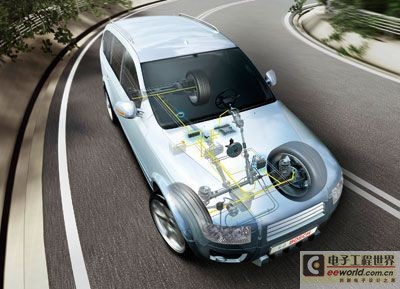Bosch uses the Vehicle Dynamics Management System (VDM) to network the Electronic Stability Program (ESP) with other active vehicle systems that affect vehicle driving performance. This innovative network system enables ESP, active steering system, active chassis system and power system to communicate with each other. This mutual communication between different systems can provide better assistance to the driver, further improve the stability, safety and power of driving, and make driving pleasure to the extreme.

VDM system improves driving stability and safety
The VDM system integrates ESP, active steering system, active chassis system and power system, etc., which further improves driving stability, safety and power.
The VDM system utilizes existing sensors, control units, actuators and centralized coordination actions. It can implement new auxiliary functions appropriately according to different situations. Mr. Herbert Heming, Vice President of Sales of Bosch Chassis Control Systems, said: "By integrating different systems through the VDM system, we can fully utilize the huge potential of advanced driving dynamics systems for the first time."
Maintain good tracking through coordinated braking and steering
Two steering support systems developed by Bosch with the characteristics of the VDM system have served the market-Dynamic Steering Angle Control (DSA) and Dynamic Steering Torque Control (DST). DSA can actively control the steering angle of the wheels, while DST is used for electric power steering vehicles.
DSA can independently increase or decrease the steering angle of the front wheels of the vehicle. For example, when the driver makes a quick lane change and the vehicle is flicking, the DSA will automatically reduce the steering angle of the front wheels, thereby avoiding the vehicle from slipping at an early stage. Usually, such a quick, minimal adjustment occurs without the driver's awareness of the steering wheel, but it ensures that the vehicle is moving in the correct direction of travel. If the sideslip condition continues to intensify, ESP will brake the appropriate wheels individually to ensure complete stability of the vehicle. This optimized coordinated steering and braking function greatly improves the stability and flexibility of the vehicle. For example, in order to maintain stability during the avoidance operation, ESP must reduce the vehicle speed to a lower level than current solutions.
DST is also connected to the ESP system. Rather than automatically correcting the steering angle through the front wheels, this function helps the driver to control the vehicle with optimal driving steering in a critical driving situation. This function helps the driver instinctively find the best steering angle by increasing or decreasing the effect of the electronic power steering system.
The two functions of DSA and DST have the feature of further shortening the braking distance, and their unique value and function can be fully manifested in dangerous situations, such as when braking is required. When the tires on both sides of the vehicle are on dry and slippery roads, this division of labor can provide additional benefits. While the steering system prevents the vehicle from slipping sideways, the braking system can be fully used for vehicle deceleration and can achieve greater braking force. Compared with vehicles equipped with ESP, it can shorten the braking distance by 10%.
Dynamic driving mode: brake system, chassis system and power system work together
Bosch has also developed VDM system functions for chassis systems and power systems based on connection with ESP. At present, the semi-active shock absorber can be used to reduce the front-to-rear and left-right swings when braking with full force and improve the braking distance by balancing the wheel load. In the future, when the vehicle turns sharply, people will be able to use the information stored in the ESP to realize the autonomous steering of the vehicle through the active anti-rollover stabilization system. Since the vehicle will be able to make a more appropriate response according to the driver's actions, the VDM function will increase the stability of the vehicle and ensure the dynamic performance of the vehicle during driving.
In order to improve the driving dynamics of the vehicle in corners, ESP data has been used to adjust the steering torque. The dynamic wheel torque control (DWT) function in VDM can reduce the torque of the inner wheels while increasing the torque of the outer wheels, which can enable the vehicle The steering is more sensitive and the turning radius is smaller, which not only increases the driving flexibility, but also enhances the driving pleasure. To this end, Bosch has developed two technical solutions. One of them is based on the activation of a special distribution gear, which can distribute the driving torque of the car arbitrarily, so that the vehicle has better acceleration on the ground with different friction coefficients, such as on a semi-dry and semi-smooth ground. Now, with Bosch launching the newly developed ESP Extreme Edition, a technically simpler and more economical version of DWT has appeared. A suitable engine control program has been linked to the new and current state-of-the-art ESP version to provide flexible and convenient brake pressure control, enabling vehicles to achieve similar flexibility without installing active distribution gears.
Shenzhen Kaixuanye Technology Co., Ltd. , https://www.iconlinekxys.com